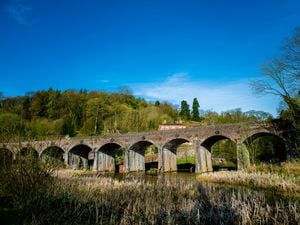Huge crane gets to work at Bedlam Furnaces as renovation work continues
A huge crane has been working on the Bedlam Furnaces in Ironbridge as the next stage of a rescue project begins.

Scaffolding has already sprung up around the site and now the crane is being used to put in a frame that will hold up a new canopy protecting the historic furnaces from the elements, keeping them safe for future generations.
The major structural steels that will hold the main roof purlins are now being installed.
Each purlin, or horizontal roof beam weighs around six tonnes, which explains why so much scaffolding is needed around the furnaces.
The Bedlam Furnaces are classed as being “at risk” by Historic England, and work has now begun to protect the site for the future.
The scaffolding will allow a huge canopy to be put over the furnaces, which will protect it from the elements in future.
The Grade II* listed Scheduled Ancient Monument, just off the B4373, is in need of urgent stabilisation and conservation.
Several severe winters and the exposed nature of the structure have caused the deterioration of the brickwork and hard cappings and the general deterioration in its condition.
It is thought to be the last surviving furnace of its kind in the country.
While Abraham Darby I came to Coalbrookdale in 1708 or 1709 to begin work perfecting the use of coke to smelt iron, it wasn’t until about two or three decades later that it took off.
Paul Gossage, a spokesman for the Ironbridge Gorge Museums Trust, said the Bedlam Furnaces were the first to be built specifically for the process of using coke to smelt iron, which makes them significant in the area’s role as part of the industrial revolution.
Mr Gossage, said: “We are at a very exciting stage of the project. After years of planning and fundraising we are now seeing the installation of the steel work, which will reveal the outline of the structure. The new cover should be complete by the early autumn, ready to protect this internationally important industrial monument from the elements.”
The total build will take about four months. Once the cover is in place, workers will then begin doing work to protect the masonry.
The project is set to cost £1.2 million





